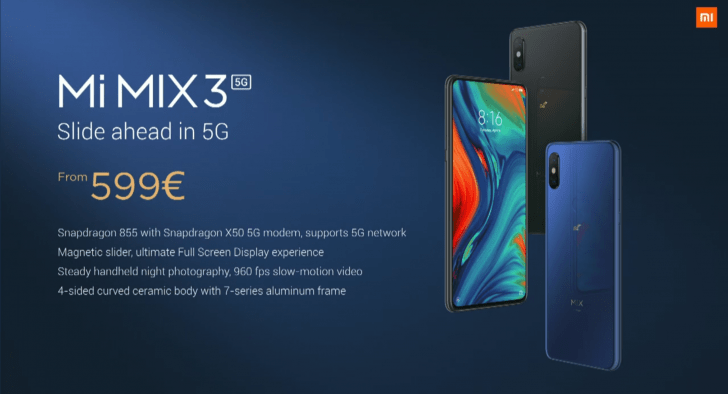Any links to online stores should be assumed to be affiliates. The company or PR agency provides all or most review samples. They have no control over my content, and I provide my honest opinion.
The two things everyone was talking about at MWC were foldable phones and 5G. The Huawei Mate X lived up to the hype then sadly ruined my dreams of ever affording one with its £2000 price tag, they wouldn’t even allow me to touch it.
MWC this year had a large number of announcements for things that are not immediately available yet either, with unknown price tags. Pretty much everything 5G. OnePlus claim to be releasing one of the first 5G phones to the market, but their announcement at MWC had nothing but a product image, which may or may not be the final design. There is a Samsung 5G S10, and the LG V50 ThinQ is 5G enabled, neither have a solid release date or price, both could likely crack the £1k barrier.
So, what are the best phones announced at MWC that you can realistically afford and buy within the next few months?
6. LG G8 ThinQ

The LG V50 ThinQ was certainly more interesting with the bizarre dual-screen design, bringing back some weird to the V series, but it is the G8 that will be the sensible investment.
The new phone has an attractive OLED screen measuring 6.1 inches from corner to corner with 3,120 by 1,440 pixels, with HDR10 support. There is a large notch which is very 2018 and makes this sit behind some of the choices in the list.
The phone uses a speaker is located behind the glass and vibrates the screen itself rather than a standard flexible membrane. This helps provide waterproofing features to the phone.
There is under display fingerprint scanning, LG instead has a rear sensor and now the world’s first vein recognition feature for security. The phone can extract an image of the owner’s veins (in their hand) via infrared absorption characteristics of haemoglobin in the blood. LG says it is practically impossible to forge this type of information for hacking purposes.
They have also introduced Air Motion which allows the phone to recognise the shape and movement of your hand when it’s held close to the screen. This will enable you to use touchless controls or gestures to interact with calls, alarms, music, and even screenshots. I can’t personally see how practical that is.
For the camera, there is a 12MP main camera and a 16MP wide-angle camera with an 8MP front camera.
The rest of the spec is mostly standard, a Qualcomm Snapdragon 855 processor with 6GB of memory and 128GB of storage and a 3,500mAh.
A 3.5mm headphone jack is included with a 32-bit quad-DAC which could be the key feature for any audiophiles.
There is no official pricing but the phone will ship in the coming weeks. Last years model started at £599 so expect to pay a little more.
5. Nokia 9 PureView

For camera fans the Nokia 9 PureView has something genuinely unique and untested for smartphones, this uses a 5-lens camera using the technology developed by Light which works together to capture 60 megapixels of data for every image. It has the potential to be the best phone camera phone on the market by a long shot, and it arrives at a reasonable price of £550.
Unfortunately, there are downsides, and this phone only has a Snapdragon 845 chipset, it is not that it is bad, but other phones are priced around the same and use this year’s Snapdragon 855.
4. Sony Xperia 1

The Xperia 1 arrives with huge 6.5-inch OLED 4K screen which offers a stunning 21:9 aspect ratio and improved colour accuracy.
The Xperia 1 marks the first time the company has introduced a triple camera to one of its smartphones. It uses a 12MP wide sensor, 12MP telephoto and a 12MP super wide sensor.
The battery inside the Xperia 1 is 3330mAh, which is disappointingly small for a 4K display.
As you would expect the phone has a Qualcomm Snapdragon 855 processor with 6GB of memory and 128GB of storage.
One of the concerns is the £849 asking price, making it much more expensive than the XZ3 was at launch and more expensive than the newly announced Galaxy S10. The Sony Mobile division has been losing money, and while phones like the Huawei Mate 20 Pro and S10 can command steep prices, I think Sony is pushing it here.
3. Xiaomi Mi Mix 3 5G

I would have placed this higher on my list, but Xiaomi loses a couple of points for rehashing the Mi Mix 3 in order to get the first 5G phone out. However, with a launch price of around £520 and availability from May, it will be one of if not the first phone to arrive with 5G and one of the cheapest 5G models of the year.
To get the 5G functionality, Xiaomi had to update the internal to the Qualcomm Snapdragon 855 which is combined with the X50 modem.
Elsewhere, the Xiaomi Mi Mix 3 packs all the features of its non-5G predecessor; you’ll find a 6.39in FHD+ AMOLED screen with a sliding design to access the front-facing camera, a rear-mounted 12MP AI dual camera and 256GB built-in storage.
2. Samsung Galaxy S10

The Galaxy S series is traditionally the best-selling flagship Android phone on the market. This year they have introduced the usual strong line-up as well as adding a cheaper S10e model.
The S10e could arguably be the stand out phone with a £669 price tag making it much more wallet-friendly than previous generations. If your pockets are deeper you will be rewarded with a better camera, and the new ultrasonic under display fingerprint reader. You can read the full announcement details here.
1.Xiaomi Mi 9

The Xiaomi Mi 9 won a lot of awards at MWC, and comes top of my list, nothing is particularly unique or standout about it but it ticks all the boxes for a 2019 flagship device while offering exceptional value for money at 449-Euros for the base model of 6GB/128GB, so maybe £410 if we are lucky. The 6GB/128GB model which is probably preferably is still only 499-Euros or about £450
It has a 6.39in Samsung AMOLED screen with a waterdrop notch housing a 20Mp selfie camera. The display covers 90.7% of the front surface of the phone, with a reduced chin (now just 4.6mm) and tall 19:9 aspect ratio. A fingerprint sensor is built-in and operates 25% faster than on the Mi 8 Pro and Mi 8 Explorer.
The Mi 9’s new triple-lens configuration is rated at 48Mp + 16Mp + 12Mp, all hidden behind tough Sapphire glass.
Then there is the Qualcomm Snapdragon 855 processor which does the grunt work. The battery is rated at 3,300mAh, which is 100mAh down on the Mi 8, but it has been upgraded to support super-fast 27W wired charging and 20W wireless charging.
The battery is lower than I would like to see but you can’t argue with the price and this could easily dethrone OnePlus as the best affordable flagship phone of the year.
I am James, a UK-based tech enthusiast and the Editor and Owner of Mighty Gadget, which I’ve proudly run since 2007. Passionate about all things technology, my expertise spans from computers and networking to mobile, wearables, and smart home devices.
As a fitness fanatic who loves running and cycling, I also have a keen interest in fitness-related technology, and I take every opportunity to cover this niche on my blog. My diverse interests allow me to bring a unique perspective to tech blogging, merging lifestyle, fitness, and the latest tech trends.
In my academic pursuits, I earned a BSc in Information Systems Design from UCLAN, before advancing my learning with a Master’s Degree in Computing. This advanced study also included Cisco CCNA accreditation, further demonstrating my commitment to understanding and staying ahead of the technology curve.
I’m proud to share that Vuelio has consistently ranked Mighty Gadget as one of the top technology blogs in the UK. With my dedication to technology and drive to share my insights, I aim to continue providing my readers with engaging and informative content.







